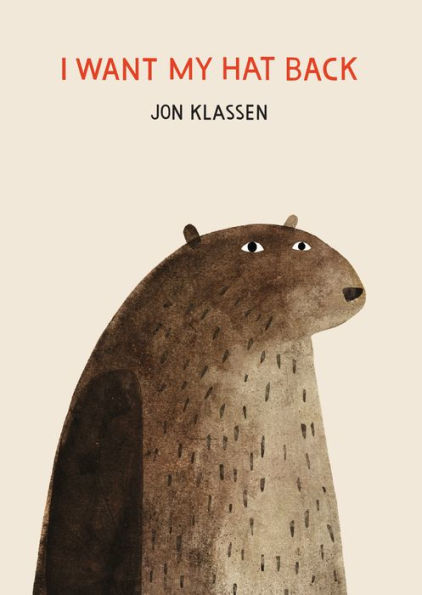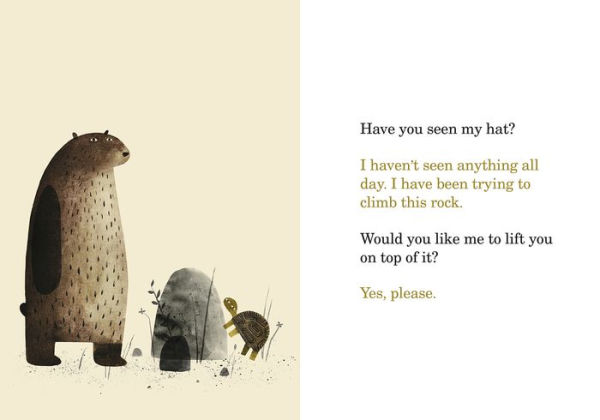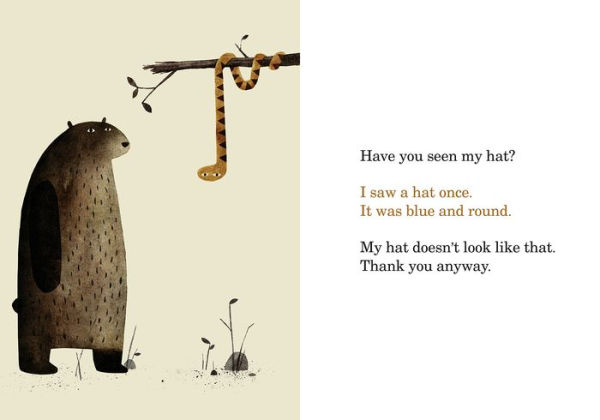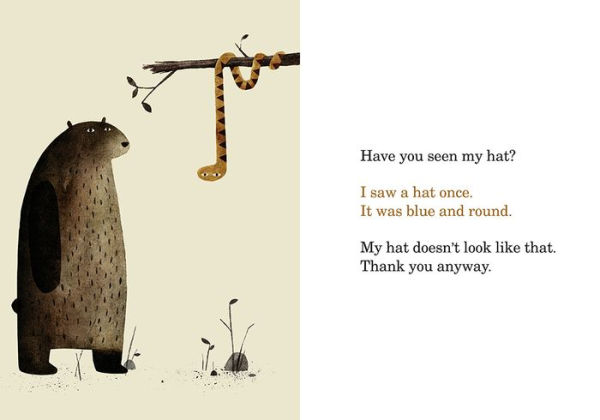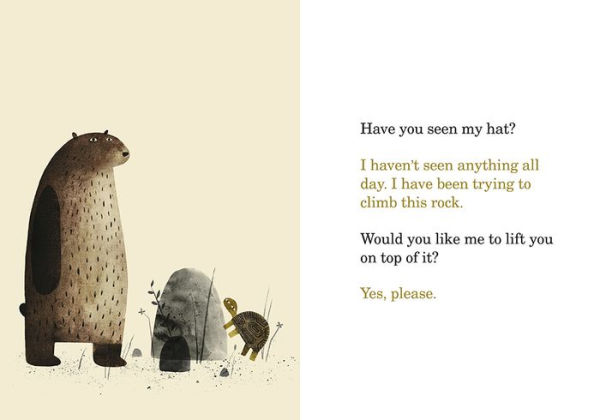A marvelous book in the true dictionary sense of “marvel": it is a wonderful and astonishing thing, the kind of book that makes child laugh and adult chuckle, and both smile in appreciation. A charmingly wicked little book.
—The New York Times
Deliberately understated, with delectable results… Skillful characterizations; though they're simply drawn and have little to say, each animal emerges fully realized.
—Publishers Weekly (starred review)
Read aloud, this story will offer many sublime insights into how young readers comprehend an illustrated text that leaves out vital information, and will leave young sleuths reeling with theories about what just happened.
—School Library Journal
Klassen's animation and design skills are evident on every page in this sly, subversive tale... Adults and older children will chuckle mordantly at rabbit's sudden disappearance, while young children might actually wonder, with Squirrel, where the rabbit has gone.
—The Horn Book
Indubitably hip, this will find plenty of admirers.
—Kirkus Reviews
You know, bears may stand for adults in some way, because they’re big, they’re ungainly, they’re goofy. They’re like most of us grownups. But the bear in this book paws down; he’s got to be the dimmest, most slow-witted, brilliantly stupid bear to come along in years. I really love him.
—NPR Weekend Edition
Four pages into this charmer, every kindergartner will know where the bear’s missing hat is — but they’ll never predict the hilarious revenge he takes on the thief.
—People Magazine
A sly picture book...Young readers and listeners will love being in on the joke, making them appreciate the story's humor even more.
—BookPage
The joy of this book lies in figuring out the explicit plot from the implicit details in the pictures, especially a few wordless ones.
—Chicago Tribune
A coterie of woodland animals is drawn in a minimalistic style and a palette of browns with a splash of red. The dialogue is simple and sly.
—The Boston Globe
This is a familiar picture-book formula with a twist, and the minimalist style Klassen employs with both text and art only emphasizes the humor of the situation....While these design choices and the simplicity and pattern of the text would make this a good choice for beginning readers, it would also make an amusing readaloud or a great little readers’ theater piece.
—Bulletin of the Center for Children's Books
Read I Want My Hat Back by Jon Klassen. It’s the most subtle endorsement of murder you’ll ever find.
—GQ.com
This is a must-have for any primary or even intermediate classroom. It’s about inference and being a good reader.
—Huffington Post
I Want My Hat Back is a marvelous book in the true dictionary sense of "marvel": it is a wonderful and astonishing thing, the kind of book that makes child laugh and adult chuckle, and both smile in appreciation…It may take younger children a few readings to understand the story in full, but when they do, they will savor it all the more. Adult readers, for their part, will surely anticipate Klassen's next picture book in the same way they yearn for a new Mo Willems or relish a William Steig classic. This is a charmingly wicked little book and the debut of a promising writer-illustrator talent.
—The New York Times
In his first outing as an author, Klassen's (Cats' Night Out) words and artwork are deliberately understated, with delectable results. Digitally manipulated ink paintings show a slow-witted bear asking half a dozen forest animals if they've seen his hat. Unadorned lines of type, printed without quotation marks or attributions, parallel the sparse lines Klassen uses for the forest's greenery. Most of the answers the bear gets are no help ("What's a hat?" one animal asks), but the rabbit's answer arouses suspicion: "I haven't seen any hats anywhere. I would not steal a hat. Don't ask me any more questions." In a classic double-take, the bear doesn't notice the hat on the rabbit's head until several pages on: "I have seen my hat," he realizes, wide-eyed. Readers with delicate sensibilities may object to the implied conclusion ("I would not eat a rabbit," the bear says stoutly, his hat back on his head, the forest floor showing signs of a scuffle), but there is no objecting to Klassen's skillful characterizations; though they're simply drawn and have little to say, each animal emerges fully realized. A noteworthy debut. Ages 4–8. (Sept.)
Gr 1–3—Readers may be too young to know Nixon's famous line, "I am not a crook," but they'll surely figure out that someone here is not telling the truth. Bear has lost his hat and asks various creatures if they have seen it, with pronounced civility. Snake goes offtrack (and will also throw inattentive listeners offtrack) by announcing he's seen a blue and round hat. Rabbit vigorously denies having seen anything like it, despite evidence to the contrary. Armadillo asks, "What is a hat?" Bear is flung into despair until a young deer asks, "What does your hat look like?" Bear starts to describe it and immediately realizes he has seen it. The following page is painted red with anger. Readers realize they have seen it, too! Bear confronts the culprit and what happens next is a matter of interpretation. Violence is implied, but only indirectly. The Chinese ink illustrations are understated and stylized, and the pages are a natural sandy hue throughout. The dialogue is not in quotations but in contrasting colors. Wisps of grass, rocks, small branches, and specks of dirt compose the setting. Read aloud, this story will offer many sublime insights into how young readers comprehend an illustrated text that leaves out vital information, and will leave young sleuths reeling with theories about what just happened.—Sara Lissa Paulson, American Sign Language and English Lower School PS 347, New York City
Klassen's coy effort combines spare illustration, simple, repetitive text and a "payback's a bear" plot.
A somber, sepia-toned bear longs for his missing hat and questions a series of forest animals about its whereabouts. While everyone denies seeing it, a rabbit (sporting, readers will note, a pointy red chapeau) protests a bit too indignantly. Ten pages on, as the bear describes his hat for a solicitous deer, realization hits: "I HAVE SEEN MY HAT." The accompanying illustration shows the indignant bear suffused in the page's angry red. There's the subsequent dash and confrontation, followed by bear in hat and rabbit—well, nowhere to be seen. Klassen's ink-and-digital creatures, similarly almond-eyed and mouth-less, appear stiff and minimalist against creamy white space. Foliage is suggested with a few ink strokes (though it's quite bashed-up after rabbit goes missing). The text type, New Century Schoolbook, intentionally evokes the visually comfy, eminently readable design of 1960s children's primers. Font colors correlate with the animals' dialogue as well as the illustrations' muted color palette, and the four-sentence denials (first rabbit's, then bear's) structurally echo each other. Indubitably hip, this will find plenty of admirers. Others might react to a certain moral vapidity. And the littlest ones will demand to know where the heck that rabbit went.
Cynical on wry. (Picture book. 4-7)






